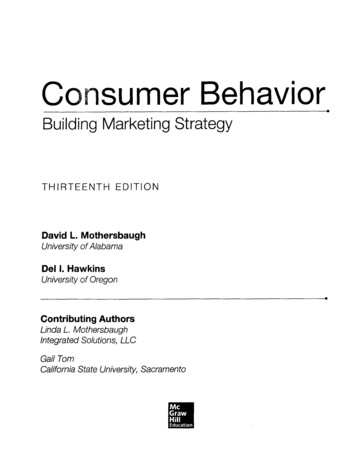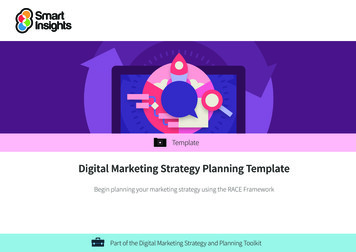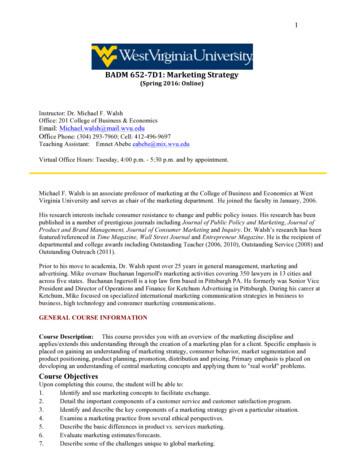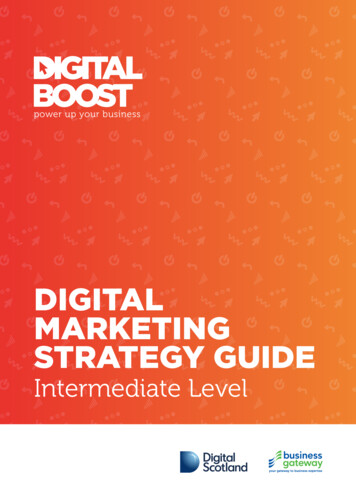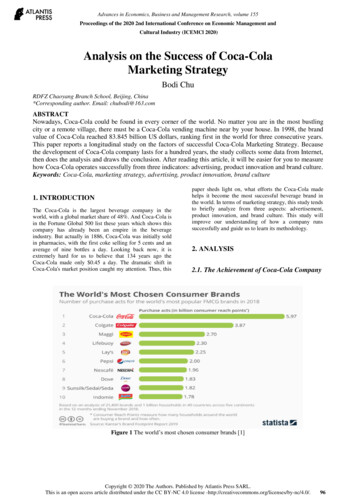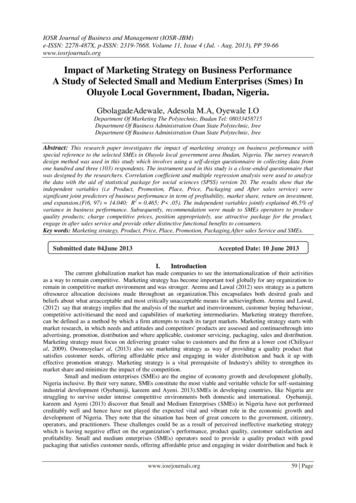
Transcription
IOSR Journal of Business and Management (IOSR-JBM)e-ISSN: 2278-487X, p-ISSN: 2319-7668. Volume 11, Issue 4 (Jul. - Aug. 2013), PP 59-66www.iosrjournals.orgImpact of Marketing Strategy on Business PerformanceA Study of Selected Small and Medium Enterprises (Smes) InOluyole Local Government, Ibadan, Nigeria.GbolagadeAdewale, Adesola M.A, Oyewale I.ODepartment Of Marketing The Polytechnic, Ibadan Tel: 08033458715Department Of Business Administration Osun State Polytechnic, IreeDepartment Of Business Administration Osun State Polytechnic, IreeAbstract: This research paper investigates the impact of marketing strategy on business performance withspecial reference to the selected SMEs in Oluyole local government area Ibadan, Nigeria. The survey researchdesign method was used in this study which involves using a self-design questionnaire in collecting data fromone hundred and three (103) respondents. The instrument used in this study is a close-ended questionnaire thatwas designed by the researchers. Correlation coefficient and multiple regression analysis were used to analyzethe data with the aid of statistical package for social sciences (SPSS) version 20. The results show that theindependent variables (i.e Product, Promotion, Place, Price, Packaging and After sales service) weresignificant joint predictors of business performance in term of profitability, market share, return on investment,and expansion.(F(6, 97) 14.040; R2 0.465; P .05). The independent variables jointly explained 46.5% ofvariance in business performance. Subsequently, recommendation were made to SMEs operators to producequality products; charge competitive prices, position appropriately, use attractive package for the product,engage in after sales service and provide other distinctive functional benefits to consumers.Key words: Marketing strategy, Product, Price, Place, Promotion, Packaging,After sales Service and SMEs.Submitted date 04June 2013Accepted Date: 10 June 2013I.IntroductionThe current globalization market has made companies to see the internationalization of their activitiesas a way to remain competitive. Marketing strategy has become important tool globally for any organization toremain in competitive market environment and was stronger. Aremu and Lawal (2012) sees strategy as a patternofresource allocation decisions made throughout an organization.This encapsulates both desired goals andbeliefs about what areacceptable and most critically unacceptable means for achievingthem. Aremu and Lawal,(2012) say that strategy implies that the analysis of the market and itsenvironment, customer buying behaviour,competitive activitiesand the need and capabilities of marketing intermediaries. Marketing strategy therefore,can be defined as a method by which a firm attempts to reach its target markets. Marketing strategy starts withmarket research, in which needs and attitudes and competitors' products are assessed and continuesthrough intoadvertising, promotion, distribution and where applicable, customer servicing, packaging, sales and distribution.Marketing strategy must focus on delivering greater value to customers and the firm at a lower cost (Chiliyaetal, 2009). Owomoyelaet al, (2013) also see marketing strategy as way of providing a quality product thatsatisfies customer needs, offering affordable price and engaging in wider distribution and back it up witheffective promotion strategy. Marketing strategy is a vital prerequisite of Industry's ability to strengthen itsmarket share and minimize the impact of the competition.Small and medium enterprises (SMEs) are the engine of economy growth and development globally,Nigeria inclusive. By their very nature, SMEs constitute the most viable and veritable vehicle for self-sustainingindustrial development (Oyebamiji, kareem and Ayeni. 2013).SMEs in developing countries, like Nigeria arestruggling to survive under intense competitive environments both domestic and international. Oyebamiji,kareem and Ayeni (2013) discover that Small and Medium Enterprises (SMEs) in Nigeria have not performedcreditably well and hence have not played the expected vital and vibrant role in the economic growth anddevelopment of Nigeria. They note that the situation has been of great concern to the government, citizenry,operators, and practitioners. These challenges could be as a result of perceived ineffective marketing strategywhich is having negative effect on the organization‟s performance, product quality, customer satisfaction andprofitability. Small and medium enterprises (SMEs) operators need to provide a quality product with goodpackaging that satisfies customer needs, offering affordable price and engaging in wider distribution and back itwww.iosrjournals.org59 Page
Impact Of Marketing Strategy On Business PerformanceA Study Of Selected Small And Mediumup with effective promotion strategy in order to survive the pressure from global market competitiveenvironment.The main objective of this research work is to examine the impact of marketing strategies on businessperformance with special reference to the selected small and medium enterprises (SMEs) in Oluyole localgovernment, Ibadan, Nigeria.II.Literature ReviewThere are numerous definitions of marketing strategy in the literature and such definitions reflectdifferent perspectives ( Liet al, 2000). However, the consensus is that marketing strategy provides the avenuefor utilizing the resources of an organization in order to achieve its set goals and objectives. Marketing strategyis define as in a given market area, the proper allocation of resources to support enterprises to win competitiveadvantage. Goi (2005) define marketing strategy as the set of the marketing tools that firms use to pursue theirmarketing objectives in the target market; the view which was earlier expressed by (Gronroos, 1999, andOsuagwu, 2006).Therefore, the function of marketing strategy is to determine the nature, strength, direction, andinteraction between the marketing mix- elements and the environmental factors in a particular situation.According to (owomoyela, et al, 2013), the aim of the development of an organization‟s marketing strategydevelopment is to establish, build, defend and maintain its competitive advantage. Managerial judgment isimportant in coping with environmental ambiguity and uncertainty in strategic marketing.Lin (1993) as cited in Long-Yi and Ya – Huei,(2012) proposes that marketing strategy can be dividedinto four ways to research that: (1) Dual-oriented marketing strategy: using rational and emotional productname, easy to remember, and pricing to take into account the cost of service and quality orientation,psychological factors and competitors‟ prices. (2) Rational marketing strategy: the use of functional demands ofa rational position, consider after-sales service, warranties, delivery and installation attached by the productfactors. (3) Emotional marketing strategy: the emotional appeal to locate, emphasis on physical product shape,color design, the use of emotional product names, and so on memory, attention to product packaging andlabeling. (4) Maintenance marketing strategy: consumers are more concerned about price and quality, it is notsuitable to use a lot of marketing techniques, manufacturers can improve product packaging and labeling, give asimple name for remember, consider the quality position and competitor pricing during pricing. Lin (1993)divides marketing strategy into four parts, that is dual-oriented, rational, emotional and low involvement,different product types with different marketing strategy, so the manufacturer‟s marketing strategy can bedivided into five parts which is the choice of target market, product strategy, pricing strategy, channel strategyand marketing strategy. He use a total of 29 questions to measure new product marketing strategy and sevenpoints Likert scale is used to measure. When the industry lack of competition, the business performance wouldbe better even when companies are not entirely market-driven, the performance will have a more excellentperformance (Kohliet al., 1993).Previous studies have established relationships between the marketing strategies and performance (Owomoyelaet al, 2013; Shoham, 2002; Theodosiou&Leonidou, 2003). Leonidou, Katsikeas and Samiee (2002)propose a study in which a meta-analysis was also conducted to evaluate the relationships between themarketing strategies and performance.2.1PRODUCT STRATEGYKotler and Armstrong (2006) define a product as anything that can be offered to a market for attention,acquisition, use, or consumption that might satisfy a want or need. They further define a consumer product asthe product bought by the final consumer for personal consumption. Consumers buy products frequently, withcareful planning, and by comparing brands based on price, quality and style.Borden, (1984) sees a product asabout quality, design, features, brand name and sizes. Mohammad et al, (2012) also say that product is thephysical appearance of the product, packaging, and labelingInformation, which can also influence whetherconsumers notice a product in-store, examine it, andpurchase it. past researchers have clearly suggested thatproduct influences have a significant impact on business performance (KazemandHeijden, 2006; Kemppainen,Vepsäläinen, andTinnilä, 2008; Ogunmokun and Esther, 2004; Owomoyelaet al, 2013),2.2PRICING STRATEGYkotler (2007) defines price as a cost of producing, delivering and promoting the product charged by theorganization. Zeithaml (1988) is of the view that monetary cost is one of the factors that influence consumer‟sperception of a product‟s value. Price can be stated as the actual or rated value of a valuable product which is upfor exchange; some define it as amount of money paid for product (Kotleret al, 2005). In the studies of Colpan,(2006); Dooleet al., (2006) and Owomoyelaet al, (2013) they establish significant relationship between priceand business performance. The price you set for your product or service plays a large role in its marketability.www.iosrjournals.org60 Page
Impact Of Marketing Strategy On Business PerformanceA Study Of Selected Small And MediumPricing for products or services that are more commonly available in the market is more elastic, meaning thatunit sales will go up or down more responsively in response to price changes (Jones, 2007).2.3PROMOTION STRATEGYZeithamlet al. (1995) describe promotion as part of specific effort to encourage customers to tell othersabout their services. According to Duncan (2005), promotion is the key to the marketexchange process thatcommunicates with present and potential stakeholders, and the generalpublic. Every firm or store must cast itselfinto the role of communicator and promoter. Hakansson (2005) also reports that promotion appears as an issueof how to create an optimal mix of marketing communication tools in order to get a product's message and brandfrom the producer to theconsumer. Borden, (1984) defines promotion as sales promotion, advertising, personalselling, public relations and direct marketing. Kotler, (2007) discovers that Promotions have become a criticalfactor in the product marketing mix which consists of the specific blend of advertising, personal selling, salespromotion, public relations and direct marketing tools that the company uses to pursue its advertising andmarketing objective. Previous researches (Amine and Cavusgil, 2001; Francis and Collins-Dodd, 2004) haveestablished significant relationship between promotion and business performance.2.4PLACE STRATEGYJones, (2007) defines place as any way that the customer can obtain a product or receive a service.Bowersox and Closs (1996) give distribution as another name for place. According to them, it is the thirdelement of the marketing mix, and it encompasses all decisions and tools which relate to making products andservices available to customers. Kotler and Armstrong (2006),also define place or distribution as a set ofinterdependent organizations involved in the process of making a product available for use or consumption byconsumers. Place strategy calls for effective distribution of products among the marketing channels such as thewholesalers or retailers (Berman, 1996). Owomoyela et al, (2013); Amine and Cavusgil, {2001}; andMcNaughton,( 2002) agree that place has significant effect on business performance.2.5PACKAGING STRATEGYPackaging is a crucial component of the "marketing mix" for a product. It is the "least expensive formof advertising" and is of particular importance at the point of sale, as the package is the manufacturer's lastchance to convince the customer to purchase the product (Sajuyigbeet al, 2013). Packaging is a very importantmarketing strategy to glamorize product in order to attract the consumer‟s attention. Sometimes packaging is soimportant that it cost more than the product itself in order to lure the consumers to buy it (Sajuyigbeetal,2013).Olayinka and Aminu (2006) see packaging as all activities of designing and producing the container orwrapper for a product. Kottler (2007) defines packaging as all materials products used for the containment,protection, hard delivery and presentation of goods. Packaging is the protecting products for distribution,storage, sale and use, packaging also refers to the process of design evaluation and production of packages.Packaging can be described as a coordinated system of preparing goods for transport, warehousing informationand sell. It is fully integrated into government business, institutional, industry, and personal use (Diana,2005).Sajuyigbeet al, (2013) point out that packaging is one of the inevitable communication tools thatinfluence buying behavior and enhance business performance.2.6AFTER SALES SERVICE STRATEGYAfter sales service involves a continuous interaction between the service provider and thecustomerthroughout the post-purchase product life cycle. At the time the product issold to the customer, this interaction isformalized by a mutually agreed warranty orservice contract. Urbaniak, (2001) defines after sales service asthose activities that enhance or facilitate the role and use of the product. (Asugman, et al., 1997) also defineafter sales service as those activities in which a firm engages after purchase of its product that minimizepotential problems related to product use, and maximize the value of the consumption experience. Pastresearchers (Ruben, 2012; Saccani, et al., 2007;; Raddats, 2011; Goffin and New, 2001) agree that after salesservice is a marketing strategy that enhance and establish strong and long relationship with customers, which inlong run lead to customer satisfaction, retention and profitability.2.7CHARACTERISTICS OF SMES IN THE NIGERIAN ECONOMYIn a global context, a general definition of SMEs using size and scale of operation is not easy, butwithin the fixed co-ordinates of national boundaries, it might be relatively easier. At the 13th Council meeting ofthe National Council on Industry held in July, 2001 Small and Medium Enterprises (SMEs) were defined by theCouncil as follows:2.7.1Small-Scale Industrywww.iosrjournals.org61 Page
Impact Of Marketing Strategy On Business PerformanceA Study Of Selected Small And MediumAn industry with a labour size of 11-100 workers or a total cost of not more thanN50 million, includingworking capital but excluding cost of land.2.7.2Medium Scale Industry:An industry with a labour size of between 101-300 workers or a total cost of over N50 million but notmore than N200 million, including working capital but excluding cost of land.2.7.3Large ScaleAn industry with a labour size of over 300 workers or a total cost of over N200 million, includingworking capital but excluding cost of land.Aluko, Oguntoye, and Afonja (1975) as cited in Oyebamiji, Kareem and Ayeni (2013) characterisedSMEs as follows: 1) The same manager or proprietor finds it difficult to raise short or long term capital from theorganized capital market, instead relies on personal savings or loans from friends, relatives or money lenders. 2)The same manager/proprietor handles/supervises the production, financing, marketing and personnel functionsof the enterprise. 3) The manager/proprietors vision is confined to the local community in which he carries onhis line of business. There is little or no knowledge of the wider or distant markets. 4) The rate of businessmortality is high probably because of strong mutual distrust and dominance of the sole proprietor whichmilitates against the formation of partnerships or limited liability companies. 5) The enterprise is generallypoorly equipped as the small scale industrialist feels reluctant to accept outside help owing to prejudice or fearthat information about the enterprise might reach the tax authorities or a nearby competitor. 6) Little or noaccount of business costs or revenue is kept and the banking system is hardly utilized. The result is that bankingfacilities for business financing and expansion are extended to only very few of the industrialists. 7) The level ofeducation of the proprietor is usually very low with a consequent low level of business management technique,skill or market information.III.Conceptual Model And HypothesesProductPromotionPlaceBusiness PerformancePricePackagingAfter sales serviceSource: Designed by researchersThe general form of the model was as follows: BP α β1X1 β2X2 β3X3 β4X4 β5X5 β6X6 e Where,BP Business Performance, X1 Product, X2 Promotion, X3 Place X4 Price X5 Packaging, X6 After sales service. And α is constant and β1, β2, β3, β4, β5, and β6 are coefficient to estimate, and e is theerror term.3.1 RESEARCH QUESTION: Is there significant impact of marketing strategies on business performance?Hypotheses:Ho1: Product has no positive significant impact on business performance.Ho2: Promotion has no positive significant impact on business performance.Ho3: Place has no positive significant impact on business performance.Ho4: Price has no positive significant impact on business performance.Ho5: Packaging has no positive significant impact on business performance.www.iosrjournals.org62 Page
Impact Of Marketing Strategy On Business PerformanceA Study Of Selected Small And MediumHo6: After sales service has no positive significant impact on business performance.3.23.2.1METHODOLOGYResearch design and Data collectionThe target population of this study was SMEs operators and their customers in Oluyole localgovernment in Ibadan, Nigeria. The sample for this survey was comprised of one hundred and three (103)respondents who are the SMEs operators and their customers who were randomly selected. A structuredquestionnaire was used in gathering relevant data from the respondents.3.2.2Measuring instrumentThe measurement used in this paper is the Likert Scale Method of summated ratings. It consists ofstatements where respondents indicate their degree of agreement or disagreement on a five- point scale Strongly Disagree, Disagree, Neutral, Agree, and Strongly Agree.In respect to measuring the reliability of thescale, the reliability coefficients (Cronbach‟s ) of the product, promotion, place, price, packaging and aftersales service were 0.76, 0.85, 0.82, 0.72, 0.80 and 0.77 respectively. Business performance scale was used toassess respondents‟ level of their organizational profitability, market share, and return on investment andexpansion compare with their competitors. The scale was subjected to item analysis in order to ensure it is validand reliable and it yielded reliability alpha of .76.IV.Data Analysis And InterpritationTable1: zero - Order Correlation Showing the Relationship between Business Performance andMarketing .399*.011-.502-.035*.292-.376**.432*.292**-Key: *P .05, **P .001The result in table 1 shows that the relationship between business performance and product offered to themarket, channel of distribution, price charge, packaging of the product and after sales service were positive andsignificant (r 0.422; df 6, 97; p .05; r 0.449, df 6, 97, p .01; r 0.603, df 6, 97, p .01; r 0.408, df 6, 97, p .05 and r 0.434, df 6, 97, p .01 ) respectively. This result implies that the high quality productproduced by business organizations, the effective channel of distribution employed by the businessorganizations, the affordable price charged, the attractive packaging used for the product and the effective aftersales serviceengaging in,the higher the business performance, in term of profitability, market share, return oninvestment, and expansion. However, the relationship between business performance and promotion wasnegative but significant(r -0.030; df 6, 97; p .01). This result is in line with Jayaraman and Wong, (2008)who suggest that it may be due to the consumer perception that heavily promotedproducts could be problematicproducts of poor quality, with passed expiry dates, and fromclearance stocks. Consumers may also perceive thatheavier promotions also mean that theproducts are sold at higher prices, which will turn-off consumers who arein the low-cost segmentof the consumer market.Table 2Model SummarybModelRR SquareAdjustedR Std. Error of the 85a. Predictors: (Constant), After sales service, Promotion, Packaging, Place, Product, Pricewww.iosrjournals.org63 Page
Impact Of Marketing Strategy On Business PerformanceA Study Of Selected Small And Mediumb. Dependent Variable: Business performanceTable 3ANOVAaModelSum of SquaresDfMean 97.134Total24.375103a. Dependent Variable: Business performanceb. Predictors: (Constant), After sales service, Promotion, Packaging, Place, Product, PriceSig.000bTable 4 Multiple Regression Analysis of Business Performance on Product, Promotion, Place, Price,Packaging and After sales service.ModelUnstandardized CoefficientsStandardizedCoefficientsBBetaStd. Aftersales.130.090servicea. Dependent Variable: Business performanceTSig.95.0% Confidence Intervalfor 112.250.623.338.308Table 2, 3 and 4 show that the independent variables (i.eProduct, Promotion, Place, Price, Packaging and Aftersales service) were significant joint predictors of business performance in term of profitability, market share,return on investment, expansion and etc.(F(6, 97) 14.040;R2 0.465; P .05). The independent variablesjointly explained 46.5% of variance in business performance. Furthermore, product (β 0.131; P .01); place (β 0.062; P .05); price (β 0.422; P .01); packaging (β 0.465; P .05) and after sales service (β 0.126;P .05) were significant independent predictors of business performance. These results are in line withShaharudinet al, (2009); Muhammed, et al, (2011);Sajuyigbeet al(2013); Francis and Collins-Dodd, (2004);Shamsuddoha and Ali, (2006); Chiliyaet al, (2009)and Owomoyelaet al, (2013) who agreed that marketing mixstrategy is the blood of business organization. However, onlypromotion (β -0.038; P .05) has negative impactbut significant on business performance. This result has contrary opinion to the previous researches and this maybe due to the consumer perception that heavily promotedproducts could be problematic products of poor quality,with passed expiry dates, and fromclearance stocks. Consumers may also perceive that heavier promotions alsomean that theproducts are sold at higher prices, which will turn-off consumers who are in the low-costsegmentof the consumer market.HypothesisH1.H2.H3.H4.H5.H6.Table 5: Summary of hypotheses testingTestSignificantMultiple RegressionPositive SignificantMultiple RegressionNegative SignificantMultiple RegressionPositive SignificantMultiple Regressionpositive SignificantMultiple RegressionPositive SignificantMultiple RegressionPositive ejectedRejectedSource: Authors’ Computation4.1DISCUSSIONThis study reveals that product consideration has impact on business performance in term ofprofitability, market share, return on investment, expansion etc . This is because customers do really look atproduct attributes such as quality, features, design and style.www.iosrjournals.org64 Page
Impact Of Marketing Strategy On Business PerformanceA Study Of Selected Small And MediumThe relationship between promotion consideration and business performance is significant, buttherelationship is negative. This may be due to the consumer perception that heavily promotedproducts could beproblematic products – of poor quality, with passed expiry dates, and fromclearance stocks. Consumers mayalso perceive that heavier promotions also mean that theproducts are sold at higher prices, which will turn-offconsumers who are in the low-cost segmentof the consumer market.Place consideration is seen to be another factor having an impact on business performance. This simplymeans the location, accessibility and channel of distribution employed by business organization is a majorconcern.The study also indicates that price consideration has a significant positive impact on businessperformance. This is because many Nigerians‟ consumers are motivated to buy products at lower prices. Thecustomer base in the lowprice segment of the Nigerian consumer market is big. These consumers in the low-costsegmentalways look for products that offer value for money.The study also reveals that packaging has positive impact on business performance. This is in line withChaneta,(2012) who says that packaging can increase sales by such promotionally-oriented moves as offeringsmaller or larger sizes more multipacks, better pictures of the product itself, illustrations of the product in useand more effective use of color.Positive significant relationship between after sales service and business performance is established. This simplymeans customers are motivated to buy product that has guaranty contract, installation and effective delivery.V.Conclusion And RecommendationsThe study investigates the impact of marketing strategy on business performance with special referenceto the selected small and medium enterprises operators in Oluyole local government area, Ibadan, Nigeria. Thestudy found that marketing strategies (product, place, price, packaging, and after sales service) weresignificantly independent and joint predictors of business performance. The study however, discovered thatpromotion has no positive significant effect on business performance. The study conforms to the positions ofShaharudinet al, (2009); Muhammed, et al (2011); Sajuyigbeet al (2013); Francis & Collins-Dodd, (2004);Shamsuddoha and Ali, (2006); Chiliyaet al, (2009) and Owomoyelaet al, (2013) except the result of promotionwhich has contrary opinion to the previous researches. Therefore SMEs operators should produce qualityproducts; charge competitive prices, position appropriately, use attractive package for the product, engage inafter sales service and provide other distinctive functional benefits to .[19].[20].[21].Amine, L. S., and Cavusgil, S. T. (2001). Export marketing strategies in the British clothing industry. European Journal ofMarketing, 20(7), 21-33.Aremu M.A and Lawal A.T, (2012). Exploring marketing strategy as a catalyst for performance in Nigerian telecommunicationindustry. IJMBS 2 (4), 65 – 71.Asugman, G., Johnson, J. L., and McCullough, J. (1997). The role of after-sales service ininternational marketing. Journal ofInternational Marketing, 5(4), 11-28.Barney, J. B. (1996). Gaining and sustaining competitive advantage. New York: Addison-Wesley.Borden, Neil. H. (1984) The concept of marketing mix, Journal of Advertising Research, 1 (9), 2-7.Bowersox, D, and Closs, D J. (1996).Logistic Management: An Integrated Supply Chain Process, New York, McGraw-Hill.Chiliya .N, Herbst.G, and Roberts- Combard.M (2009). The impact of marketing stratefieson profitability of small grocery shops inSouth African Townships. African Journal of Business Management 3 (3), 70 – 79.Colpan, A. M. (2006). Dynamic effects of product diversity, international scope and Keiretsu membership on the performance ofJapan‟s textile firms in the 1990s. Asian Business and Management, 5(3), 419-445.Doole, I., Grimes, T., and Demack, S. (2006). An exploration of the management practices and processes most closely associatedwith high levels of export capability in SEMs.Marketing Intelligence and Planning, 24(6), 632-647Goffin, K., and New, C. (2001).Customer support and new product development.InternationalJournal of Operations & ProductionManagement, 21(3), 275-301.Goi, C. L. (2005). Marketing Mix: A Review of „P‟.Journal of Internet Banking and Commence, 10.Grönroos, C. (1999). From Marketing Mix to Relationship Marketing: Towards A ParadigmShift in Marketing ManagementDecision, 32(2), 4-20Jayaraman M and Wong C.H (2008). Relationship between marketing mix strategy and consumer motive: An empirical study inmajor TESCO Stores. UNITARE E- JOURNAL.4 (2), 41- 56.Jones .S (2007), Exploring corporate strategy: text & cases. 8th edition.Kazem, A., and Heijden, B. V. D. (2006). Exporting firms‟ strategic choices: the case of Egyptian SEMs in the food industry.S.A.M.Advanced Management Journal, 71(3), 21-33.Kemppainen, K., Vepsäläinen, A. P. J., &Tinnilä, M. (2008). Mapping the structural properties of production p
Impact Of Marketing Strategy On Business PerformanceA Study Of Selected Small And Medium www.iosrjournals.org 61 Page Pricing for products or services that are more commonly available in the market is more elastic, meaning that unit sales will go up or down more res





